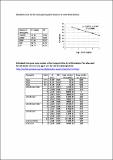Por favor, use este identificador para citar o enlazar a este item:
http://hdl.handle.net/10261/97176COMPARTIR / EXPORTAR:
 SHARE
BASE SHARE
BASE
|
|
| Visualizar otros formatos: MARC | Dublin Core | RDF | ORE | MODS | METS | DIDL | DATACITE | |

| Título: | Production of cecropin A antimicrobial peptide in rice seed endosperm |
Autor: | Bundó, Mireia CSIC ORCID; Montesinos, Laura; Izquierdo, Esther; Campo, Sonia CSIC ORCID; Mieulet, Delphine; Guiderdoni, Emmanuel; Rossignol, Michel; Badosa, Esther; Montesinos, Emilio; San Segundo, Blanca CSIC ORCID; Coca, María CSIC ORCID | Fecha de publicación: | 22-abr-2014 | Editor: | BioMed Central | Citación: | BMC Plant Biology 14(1) : 102- (2014) | Resumen: | Abstract Background Cecropin A is a natural antimicrobial peptide that exhibits rapid, potent and long-lasting lytic activity against a broad spectrum of pathogens, thus having great biotechnological potential. Here, we report a system for producing bioactive cecropin A in rice seeds. Results Transgenic rice plants expressing a codon-optimized synthetic cecropin A gene drived by an endosperm-specific promoter, either the glutelin B1 or glutelin B4 promoter, were generated. The signal peptide sequence from either the glutelin B1 or the glutelin B4 were N-terminally fused to the coding sequence of the cecropin A. We also studied whether the presence of the KDEL endoplasmic reticulum retention signal at the C-terminal has an effect on cecropin A subcellular localization and accumulation. The transgenic rice plants showed stable transgene integration and inheritance. We show that cecropin A accumulates in protein storage bodies in the rice endosperm, particularly in type II protein bodies, supporting that the glutelin N-terminal signal peptides play a crucial role in directing the cecropin A to this organelle, independently of being tagged with the KDEL endoplasmic reticulum retention signal. The production of cecropin A in transgenic rice seeds did not affect seed viability or seedling growth. Furthermore, transgenic cecropin A seeds exhibited resistance to infection by fungal and bacterial pathogens (Fusarium verticillioides and Dickeya dadantii, respectively) indicating that the in planta-produced cecropin A is biologically active. Conclusions Rice seeds can sustain bioactive cecropin A production and accumulation in protein bodies. The system might benefit the production of this antimicrobial agent for subsequent applications in crop protection and food preservation. | URI: | http://hdl.handle.net/10261/97176 | Identificadores: | http://dx.doi.org/10.1186/1471-2229-14-102 |
| Aparece en las colecciones: | (CRAG) Artículos |
Ficheros en este ítem:
| Fichero | Descripción | Tamaño | Formato | |
|---|---|---|---|---|
| 1471-2229-14-102.xml | 100,17 kB | XML | Visualizar/Abrir | |
| 1471-2229-14-102.pdf | 2,26 MB | Adobe PDF |  Visualizar/Abrir | |
| 1471-2229-14-102-S1.tiff | 941,44 kB | TIFF |  Visualizar/Abrir | |
| 1471-2229-14-102-S2.pdf | 421,99 kB | Adobe PDF |  Visualizar/Abrir | |
| 1471-2229-14-102-S3.docx | 11,54 kB | Microsoft Word XML | Visualizar/Abrir |
CORE Recommender
Page view(s)
391
checked on 22-abr-2024
Download(s)
658
checked on 22-abr-2024
Google ScholarTM
Check
NOTA: Los ítems de Digital.CSIC están protegidos por copyright, con todos los derechos reservados, a menos que se indique lo contrario.
